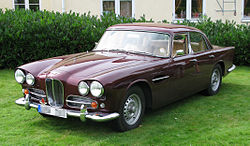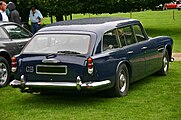Lagonda Rapide
| Lagonda | |
|---|---|
|
Lagonda Rapide (1961–1964)
|
|
| Fast | |
| Production period: | 1961-1964 |
| Class : | Sports car |
| Body versions : | limousine |
| Engines: |
Petrol engines : 3.7-4.0 liters (174-196 kW) |
| Length: | 4966 mm |
| Width: | 1765 mm |
| Height: | 1420 mm |
| Wheelbase : | 2890 mm |
| Empty weight : | 1715 kg |
| Previous model | Lagonda 3 liter |
| successor | Aston Martin Lagonda Series 1 |
The Lagonda Rapide is a four-door sports sedan from the car manufacturer Lagonda . Manufactured from 1961 to 1964, the Rapide was based on the Aston Martin DB4 and was David Brown's attempt to revive the Lagonda brand name, the name of a company he bought in 1947 and which had built its last vehicle to date in 1958.
Vehicle characteristics
The body of the Rapide was designed by Carrozzeria Touring in Milan according to detailed specifications by David Brown. At Brown's request, the car was given tail fins and a radiator grille in the shape of a collar , reminiscent of the Edsel . At the front there were double headlights that were installed offset and reproduced a motif called "Chinese Eyes", which was popular at the time and can be found on cars as different as the Triumph Herald and the Rolls-Royce Silver Cloud III in the special version by Mulliner Park Ward found.
Technically, the Rapide was based on the chassis of the Aston Martin DB4 , the wheelbase of which, however, had been extended by 400 millimeters to 2890 millimeters. A special feature compared to the original model was the De-Dion rear suspension, which was later also used in the Aston Martin DBS . Two engines were available:
- The base engine was a 3995 cm³ six-cylinder, which was an enlarged version of the engine known from the DB4 (there with 3.7 liter displacement). The power output was 236 hp at 5000 revolutions per minute. This engine was later used in the Aston Martin DB5 .
- Alternatively, the Rapide could be equipped with the (still) 3.7 liter engine of the Aston Martin DB4 Vantage , which had a revised cylinder head and was fed by three carburettors; its power was 266 hp.
A three-speed automatic transmission from BorgWarner was installed as standard for power transmission ; the four-speed gearbox of the Aston Martin DB4 was also available on request.
The two-ton car was very luxurious. Leather upholstery, power windows, radio and picnic tables in the backrests of the front seats were part of the standard equipment.
production
The Lagonda Rapide was introduced to the public in the summer of 1961 and priced at £ 4950. It was about the same as a Bristol 407 and was one of the most expensive cars of British origin. It remained on sale until 1965. During this time, 55 copies were produced, which differed greatly in detail in order to take customer requirements into account as far as possible. There were eight left-hand drive vehicles. At least one example was subsequently converted into a five-door shooting brake ; Manufacturer is "the Carrosserie Company Ltd." (and not Radford , which also converted a number of Aston Martin DB5 and DB6 into Shooting Brakes in the 1960s).
The Lagonda Rapide was only made to order. Of the 55 vehicles produced, 48 are said to still exist today.
Another fate of the Rapide
The Lagonda Rapide was David Brown's declared favorite vehicle. He had hoped for a far wider distribution of the car. On the one hand, it failed because of the high price; on the other hand, the design did not appeal to everyone, as it represented an "unspecific mixture of American and Italian lines".
John Wyer , an Aston Martin manager, tried two years after the conception to pass the design on to Alvis , where apparently the production of a four-door sedan was being considered. So far there had only been a few four-door cars that had been individually dressed by Hermann Graber in Switzerland. However, the deal failed due to resistance from David Brown.
Competitors
literature
- Andrew Noakes: Aston Martin fascination . Parragon Publishing (2006), ISBN 978-1-40547900-4
- Special Lagonda: Presentation of the Lagonda Rapide . In: Oldtimer Markt 3/1992.




